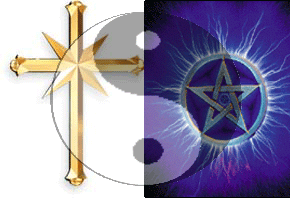Magick

The Art of Magick
Magick has been around since the beginning of history. People control the force
called "ether" with their minds to perform amazing feats. Some people
have a lot of magical ability while others have very little or none. There is a
correlation between intelligence and magical ability. One must be able to
understand and except the ways of the world and be one with it in order to use
the higher powers. There are two main kinds of magick and nine different
schools. The 2 kinds of Magick are White and Black, also known as the Yin and
the Yang. The schools of magick are abjuration, alteration, conjuration,
divination, enchantment, evocation, illusion/phantasm, invocation, and
necromancy.
Black Magick
Black Magick is centered around logic and thinking. The symbol for Black Magick
is the pentagram. Wizards and Sorcerers specialize in Black Magick. In order to
cast a spell, one must understand the abstract concepts related to that
particular spell. There are 3 phases in casting a spell. The first phase is the
summoning phase, this is where the spell caster must summon enough energy by
thinking about what they are trying to do, and concentrating on the energy
itself. If the caster gets distracted or fails to concentrate hard enough the
energy will fizzle and be wasted. The second phase is the channeling phase,
this is where the spell caster moves the energy through his body and mind to
prepare for the final phase. Most magick users focus the energy into a ball
using their hands, others might use a staff or another enchanted object. They
also speak a phrase in an ancient tongue, ones voice is key to how the spell
effect turns out. If their concentration is broken the energy could be sent
into the wrong direction and wasted. The final phase is the execution, this is
when the actual effect of the spell takes place.
White Magick
White Magick is based on emotion and will power. The symbol for White Magick is
the cross. Clerics and Druids specialize in White Magick. Casting a white
magick spell is different then casting black magick because instead of thinking
about abstract concepts, you must "will" the event to happen through
certain rituals. The main part of casting a White Magick spell is repeating a
specific chant. While chanting you must focus and want the event to occur.
Motivation, tranquility, and persistence are key elements for the Priest. White
Magick is closely tied in with Piedism.
The 9 Schools of Magick
Abjuration - Deals with protective magick and shields
Alteration - Alters physical reality
Conjuration - Summons something from another location to the caster
Divination - Deals with seeing things that are normally hidden to you
Enchantment - Alters mental reality
Evocation - Energy that is summoned from one-self
Illusion/Phantasm - Causes being(s) to perceive something that is not there
Invocation - Energy that is summoned from a greater source
Necromancy - Deals with channeling life energy from one place to another
Back